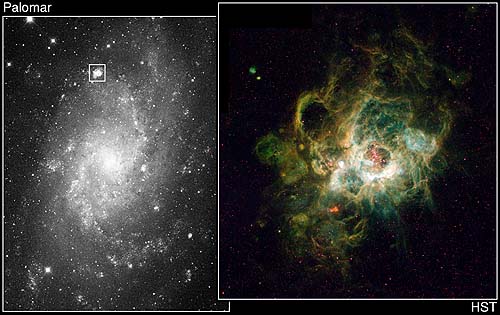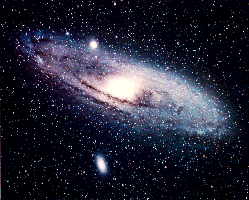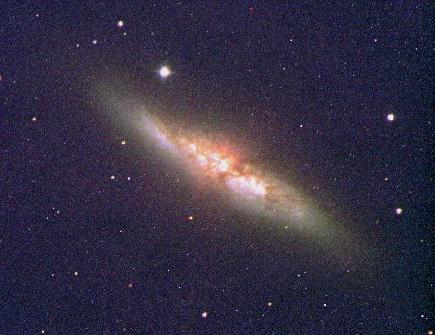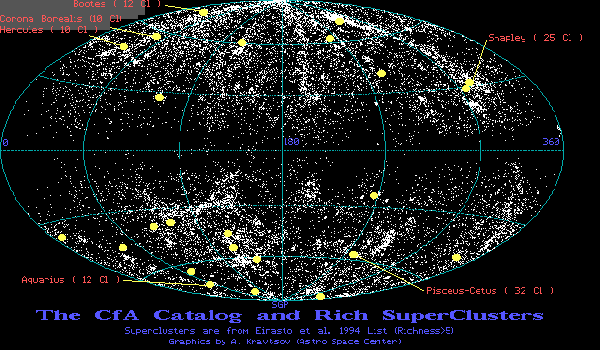
|
Galaxies and Clusters of
Galaxies: The home to billions and billions of stars |

This is a Hubble Space
Telescope image of a vast nebula called NGC 604, which lies in
the neighboring spiral galaxy M33, located 2.7 million
light-years away in the constellation Triangulum. This is a
site where new stars are being born in a spiral arm of the
galaxy. At the heart of NGC 604 are over 200 hot stars, much
more massive than our Sun.They heat the gaseous walls of the
nebula making the gas fluoresce. By studying the physical
structure of a giant nebula, astronomers may determine how
clusters of massive stars affect the evolution of the
interstellar medium of the galaxy. The nebula also yields
clues to its star formation history and will improve
understanding of the starburst process when a galaxy undergoes
a "firestorm" of star formation.

The giant Elliptical Galaxy M87 (NGC 4486) , also called Virgo A, is one of the most remarkable objects in the sky. It is perhaps the dominant galaxy in the closest big cluster to us, the famous Virgo Cluster of galaxies (sometimes also called "Coma-Virgo cluster" which is more acurate, as it extends into constellation Coma). M87 contains many more stars (and mass) than our own galaxy: several trillion solar masses. It is also of extreme luminosity, with an absolute magnitude of about -22. The spectra of elliptical galaxies reveals that they are composed mainly of population II stars and contain large globular clusters. They contain small amounts of gas where new stars are being born, but for the most part there is very little star formation.

M31 (NGC 224) is the
famous Spiral Andromeda
Galaxy, our nearest large
neighbor galaxy, forming the Local Group of galaxies together
with its companions (including M32 and M110, two bright dwarf
elliptical galaxies), our own Milky Way and its companions,
M33, and others. Visible to the naked eye even under moderate
conditions, Andromeda contains,
as most spiral galaxies do, interstellar gas and hot, bright
population I stars. We also see the characteristic nuclear
bulges and halos containing old, population II globular
clusters.

M82 (NGC 3034) is the prototype of an Irregular Galaxy. Its core seems to have suffered dramatically from a "recent" close encounter with its companion M81, being in a heavy starburst and displaying conspicuous dark lanes. This turbulent explosive gas flow is also a strong source of radio noise. In the infrared light, M82 is the brightest galaxy in the sky. Irregular galaxies contain large clouds of interstellar gas mixed with young and old stars and have no obvious nuclear bulge or spiral arms.


Here is one of the largest objects that anyone will ever see on the sky. Each of the fuzzy blobs in the above picture is a galaxy, together making up the Perseus Cluster, one of the closest clusters of galaxies. We view the cluster through the foreground of faint stars in our own Milky Way galaxy. It takes light roughly 300 million years to get here from there, so we only see this cluster as it existed during the age of the dinosaurs. Also known as Abell 426, the center of Perseus cluster is a prodigious source of X-ray radiation, and so helps us study how clusters formed and how gas and dark matter interact. The Perseus Cluster of Galaxies is part of the Pisces-Perseus supercluster, which spans over 15 degrees and contains over 1000 galaxies.
HUBBLE'S LAW:
In 1920 Hubble discovered
that very distant galaxies appeared to be moving away from us
according to a simple empirical law, now called Hubble's Law.
The law is stated in a simple formula: Vr=H0d, where Vr is the recession velocity
of the galaxy - computed from the spectral red shift - d is
the distance to the galaxy and H0 is Hubble's
constant H0=25
km/s/Mly=80 km/s/Mpc
(read "80 kilometers per second per
megaparsec"). In other words, the Hubble constant parameter
gives the relation between the easy to measure recession
velocity of galaxies to the very hard to-measure distance to
galaxies.

| Example(s):
A galaxy that is 600 Mpc from us
would be receding at a speed of: THE AGE OF THE UNIVERSE FORM
HUBBLE CONSTANT: |
Galaxies that are
relatively close to the Milky Way do not necessarily recede
from us; some are actually approaching us because of
gravitational attraction. Indeed, about 5 billion years from
now, just as the Sun is about to become a red giant, the
Andromeda Galaxy will collide with the Milky Way!